Rice Straw as a Natural Sorbent in a Filter System as an Approach to Bioremediate Diesel Pollution
Abstract
1. Introduction
2. Materials and Methods
2.1. Materials
2.1.1. Sample Preparation
2.1.2. Experimental Setup
2.2. Sorption Capacity and Efficiency Evaluations
2.3. Screening of Samples
2.4. Attenuated Total Reflectance Infrared (ATR-IR) Spectroscopy
2.5. Surface Morphology Characterization by Scanning Electron Microscopy (SEM)
2.6. Ex Situ Experiment via Statistical Optimization
2.6.1. One-Factor-at-a-Time (OFAT)
2.6.2. Response Surface Methodology (RSM)
Plackett–Burman Design (PBD)
Central Composite Design (CCD)
Model Validation
3. Results and Discussion
3.1. Screening of Rice Straw Samples
3.2. Spectroscopic Analysis by Attenuated Total Reflectance Transform Infrared (ATR-IR) Spectroscopy
3.3. Surface Morphology Characterization by Scanning Electron Microscopy (SEM)
3.4. Optimization of Factors Affecting the Sorption Capacities and the Efficiency of Oil/Water Absorbed by One-Factor-at-a-Time (OFAT)
3.5. Statistical Analyses by Response Surface Methodology (RSM)
3.5.1. Optimization of Factors by Plackett–Burman Design (PBD)
3.5.2. Interactions of Significant Factors Analyzed Using Central Composite Design (CCD)
3.5.3. RSM Model Validation
4. Conclusions
Author Contributions
Funding
Institutional Review Board Statement
Informed Consent Statement
Data Availability Statement
Acknowledgments
Conflicts of Interest
References
- Singh, V.; Jinka, S.; Hake, K.; Parameswaran, S.; Kendall, R.J.; Ramkumar, S. Novel Natural Sorbent for Oil Spill Cleanup. Ind. Eng. Chem. Res. 2014, S3, 11954–11961. [Google Scholar] [CrossRef]
- Pete, A.J.; Bharti, B.; Benton, M.G. Nano-Enhanced Bioremediation for Oil Spills: A Review. ACS ES&T Eng. 2021, 1, 928–946. [Google Scholar] [CrossRef]
- Wiloso, E.; Wiloso, E.I.; Barlianti, V.; Anggraini, I.F.; Hendarsyah, H. Potential of Cogon Grass as an Oil Sorbent. Indones. J. Appl. Chem. 2012, 14, 38–43. [Google Scholar] [CrossRef]
- Yang, L.; Wang, Z.; Yang, L.; Li, X.; Zhang, Y.; Lu, C. Coco Peat Powder as a Source of Magnetic Sorbent for Selective Oil–Water Separation. Ind. Crops Prod. 2017, 101, 1–10. [Google Scholar] [CrossRef]
- Goodman, B.A. Utilization of Waste Straw and Husks from Rice Production: A Review. J. Bioresour. Bioprod. 2020, 5, 143–162. [Google Scholar] [CrossRef]
- FAOSTAT. Available online: http://www.fao.org/faostat/en/#data/QC/visualize (accessed on 8 August 2021).
- Yusof, Z.M.; Misiran, M.; Baharin, N.F.; Yaacob, M.F.; Aziz, N.A.B.A.; Sanan, N.H.B. Projection of Paddy Production in Kedah Malaysia: A Case Study. Asian J. Adv. Agric. Res. 2019, 10, 1–6. [Google Scholar] [CrossRef]
- Mutert, E.; Fairhurst, T.H. Southeast Asia Developments in Rice Production in Southeast Asia. Better Crop. Int. 2002, 15, 12. [Google Scholar]
- Van Hung, N.; Maguyon-Detras, M.C.; Migo, M.V.; Quilloy, R.; Balingbing, C.; Chivenge, P.; Gummert, M. Rice Straw Overview: Availability, Properties, and Management Practices. In Sustainable Rice Straw Management; Springer International Publishing: Berlin/Heidelberg, Germany, 2020; pp. 1–13. [Google Scholar] [CrossRef]
- Mirmohamadsadeghi, S.; Karimi, K. Recovery of Silica from Rice Straw and Husk. In Current Developments in Biotechnology and Bioengineering: Resource Recovery from Wastes; Elsevier: Amsterdam, The Netherlands, 2020; pp. 411–433. [Google Scholar] [CrossRef]
- Li, W.C.; Law, F.Y.; Chan, Y.H.M. Biosorption Studies on Copper (II) and Cadmium (II) Using Pretreated Rice Straw and Rice Husk. Environ. Sci. Pollut. Res. 2017, 24, 8903–8915. [Google Scholar] [CrossRef]
- Mahamad, M.N.; Zaini, M.A.A.; Zakaria, Z.A. Preparation and Characterization of Activated Carbon from Pineapple Waste Biomass for Dye Removal. Int. Biodeterior. Biodegrad. 2015, 102, 274–280. [Google Scholar] [CrossRef]
- Kadhim, A.-S.F. Characterization the Removal of Phenol from Aqueous Solution in Fluidized Bed Column by Rice Husk Adsorbent. Res. J. Recent Sci. 2012, 1, 145. [Google Scholar]
- Dilamian, M.; Noroozi, B. Rice Straw Agri-Waste for Water Pollutant Adsorption: Relevant Mesoporous Super Hydrophobic Cellulose Aerogel. Carbohydr. Polym. 2021, 251, 117016. [Google Scholar] [CrossRef]
- Abidli, A.; Huang, Y.; Cherukupally, P.; Bilton, A.M.; Park, C.B. Novel Separator Skimmer for Oil Spill Cleanup and Oily Wastewater Treatment: From Conceptual System Design to the First Pilot-Scale Prototype Development. Environ. Technol. Innov. 2020, 18, 100598. [Google Scholar] [CrossRef]
- Purakayastha, T.J.; Das, K.C.; Gaskin, J.; Harris, K.; Smith, J.L.; Kumari, S. Effect of Pyrolysis Temperatures on Stability and Priming Effects of C3 and C4 Biochars Applied to Two Different Soils. Soil Tillage Res. 2016, 155, 107–115. [Google Scholar] [CrossRef]
- Thomsen, S.T.; Londoño, J.E.G.; Schmidt, J.E.; Kádár, Z. Comparison of Different Pretreatment Strategies for Ethanol Production of West African Biomass. Appl. Biochem. Biotechnol. 2015, 175, 2589–2601. [Google Scholar] [CrossRef]
- Hoang, A.T.; Le, V.V.; Al-Tawaha, A.R.M.S.; Nguyen, D.N.; Noor, M.M.; Pham, V.V. An Absorption Capacity Investigation of New Absorbent Based on Polyurethane Foams and Rice Straw for Oil Spill Cleanup. Pet. Sci. Technol. 2018, 36, 361–370. [Google Scholar] [CrossRef]
- Santiago Ramos, D.P.; Morgan, L.E.; Lloyd, N.S.; Higgins, J.A. Reverse Weathering in Marine Sediments and the Geochemical Cycle of Potassium in Seawater: Insights from the K Isotopic Composition (41K/39K) of Deep-Sea Pore-Fluids. Geochim. Cosmochim. Acta 2018, 236, 99–120. [Google Scholar] [CrossRef]
- Bazargan, A.; Tan, J.; McKay, G. Standardization of Oil Sorbent Performance Testing. J. Test. Eval. 2015, 43, 1271–1278. [Google Scholar] [CrossRef]
- Sun, X.F.; Sun, R.; Sun, J.X. Acetylation of Rice Straw with or without Catalysts and Its Characterization as a Natural Sorbent in Oil Spill Cleanup. J. Agric. Food Chem. 2002, 50, 6428–6433. [Google Scholar] [CrossRef]
- Garside, P.; Wyeth, P. Identification of Cellulosic Fibres by FTIR Spectroscopy Differentiation of FLAX and HEMP by Polarized ATR FTIR. Stud. Conserv. 2013, 51, 205–211. [Google Scholar] [CrossRef]
- Xu, F.; Zhu, T.T.; Rao, Q.Q.; Shui, S.W.; Li, W.W.; He, H.B.; Yao, R.S. Fabrication of Mesoporous Lignin-Based Biosorbent from Rice Straw and Its Application for Heavy-Metal-Ion Removal. J. Environ. Sci. 2017, 53, 132–140. [Google Scholar] [CrossRef]
- Boukir, A.; Fellak, S.; Doumenq, P. Structural Characterization of Argania Spinosa Moroccan Wooden Artifacts during Natural Degradation Progress Using Infrared Spectroscopy (ATR-FTIR) and X-Ray Diffraction (XRD). Heliyon 2019, 5, e02477. [Google Scholar] [CrossRef]
- Li, H.; Liu, L.; Yang, F. Oleophilic Polyurethane Foams for Oil Spill Cleanup. In Procedia Environmental Sciences; Elsevier BV: Amsterdam, The Netherlands, 2013; Volume 18, pp. 528–533. [Google Scholar] [CrossRef]
- Akaria, N.N.; Gomez-Fuentes, C.; Khalil, K.A.; Convey, P.; Roslee, A.F.A.; Zulkharnain, A.; Sabri, S.; Shaharuddin, N.A.; Cárdenas, L.; Ahmad, S.A. Statistical Optimisation of Diesel Biodegradation at Low Temperatures by an Antarctic Marine Bacterial Consortium Isolated from Non-Contaminated Seawater. Microorganisms 2021, 9, 1213. [Google Scholar] [CrossRef]
- Plackett, R.L.; Burman, J.P. The Design of Optimum Multifactorial Experiments. Biometrika 1946, 33, 305–325. [Google Scholar] [CrossRef]
- Darham, S.; Zahri, K.N.M.; Zulkharnain, A.; Sabri, S.; Gomez-Fuentes, C.; Convey, P.; Khalil, K.A.; Ahmad, S.A. Statistical Optimisation and Kinetic Studies of Molybdenum Reduction Using a Psychrotolerant Marine Bacteria Isolated from Antarctica. J. Mar. Sci. Eng. 2021, 9, 648. [Google Scholar] [CrossRef]
- Roslee, A.F.A.; Gomez-Fuentes, C.; Zakaria, N.N.; Shaharuddin, N.A.; Zulkharnain, A.; Khalil, K.A.; Convey, P.; Ahmad, S.A. Growth Optimisation and Kinetic Profiling of Diesel Biodegradation by a Cold-Adapted Microbial Consortium Isolated from Trinity Peninsula, Antarctica. Biology 2021, 10, 493. [Google Scholar] [CrossRef]
- Polak-Berecka, M.; Waśko, A.; Kordowska-Wiater, M.; Targoński, A. Application of Response Surface Methodology to Enhancement of Biomass Production by Lactobacillus Rhamnosus E/N. Brazilian J. Microbiol. 2011, 42, 1485–1494. [Google Scholar] [CrossRef]
- Darham, S.; Syed-Muhaimin, S.N.; Subramaniam, K.; Zulkharnain, A.; Shaharuddin, N.A.; Khalil, K.A.; Ahmad, S.A. Optimisation of Various Physicochemical Variables Affecting Molybdenum Bioremediation Using Antarctic Bacterium, Arthrobacter Sp. Strain AQ5-05. Water 2021, 13, 2367. [Google Scholar] [CrossRef]
- Mohanty, A.K.; Misra, M.; Drzal, L.T. Surface Modifications of Natural Fibers and Performance of the Resulting Biocomposites: An Overview. Compos. Interfaces 2012, 8, 313–343. [Google Scholar] [CrossRef]
- Ahmad, R.; Hamid, R.; Osman, S.A. Physical and Chemical Modifications of Plant Fibres for Reinforcement in Cementitious Composites. Adv. Civ. Eng. 2019, 2019, 1–18. [Google Scholar] [CrossRef]
- Singer, M.M.; Aurand, D.; Bragin, G.E.; Clark, J.R.; Coelho, G.M.; Sowby, M.L.; Tjeerdema, R.S. Standardization of the Preparation and Quantitation of Water-Accommodated Fractions of Petroleum for Toxicity Testing. Mar. Pollut. Bull. 2000, 40, 1007–1016. [Google Scholar] [CrossRef]
- Anuzyte, E.; Vaisis, V. Natural Oil Sorbents Modification Methods for Hydrophobicity Improvement. In Energy Procedia; Elsevier Ltd.: Amsterdam, The Netherlands, 2018; Volume 147, pp. 295–300. [Google Scholar] [CrossRef]
- Mi, H.; Lee, W.; Chen, C.; Yang, H. Effect of Fuel Aromatic Content on PAH Emission from a Heavy-Duty Diesel Engine. Chemosphere 2000, 41, 1783–1790. [Google Scholar] [CrossRef]
- Ibrahim, S.; Baharuddin, S.N.I.B.; Ariffin, B.; Hanafiah, M.A.K.M.; Kantasamy, N. Cogon Grass for Oil Sorption: Characterization and Sorption Studies. In Key Engineering Materials; Trans Tech Publications Ltd.: Bäch SZ, Switzerland, 2018; Volume 775, pp. 359–364. [Google Scholar] [CrossRef]
- Bhattacharyya, P.; Bhaduri, D.; Adak, T.; Munda, S.; Satapathy, B.S.; Dash, P.K.; Padhy, S.R.; Pattanayak, A.; Routray, S.; Chakraborti, M.; et al. Characterization of Rice Straw from Major Cultivars for Best Alternative Industrial Uses to Cutoff the Menace of Straw Burning. Ind. Crops Prod. 2020, 143, 111919. [Google Scholar] [CrossRef]
- Hadidi, M.; Amoli, P.I.; Jelyani, A.Z.; Hasiri, Z.; Rouhafza, A.; Ibarz, A.; Khaksar, F.B.; Tabrizi, S.T. Polysaccharides from Pineapple Core as a Canning By-Product: Extraction Optimization, Chemical Structure, Antioxidant and Functional Properties. Int. J. Biol. Macromol. 2020, 163, 2357–2364. [Google Scholar] [CrossRef]
- Chinedu Onwuka, J.; Bolanle Agbaji, E.; Olatunji Ajibola, V.; Godwin Okibe, F. Treatment of Crude Oil-Contaminated Water with Chemically Modified Natural Fiber. Appl. Water Sci. 2018, 8, 86. [Google Scholar] [CrossRef]
- Imran Ullah Sarkar, M.; Nazrul Islam, M.; Jahan, A.; Islam, A.; Chandra Biswas, J. Rice Straw as a Source of Potassium for Wetland Rice Cultivation. Geology 2017, 1, 184–189. [Google Scholar] [CrossRef]
- Wong, C.; McGowan, T.; Bajwa, S.G.; Bajwa, D.S. Impact of fiber treatment on the oil absorption characteristics of plant fibers. BioResources 2016, 11, 6452–6463. [Google Scholar] [CrossRef][Green Version]
- George, J.; Bhagawan, S.S.; Thomas, S. Effects of Environment on the Properties of Low-Density Polyethylene Composites Reinforced with Pineapple-Leaf Fibre. Compos. Sci. Technol. 1998, 58, 1471–1485. [Google Scholar] [CrossRef]
- Bajwa, D.S.; Sitz, E.D.; Bajwa, S.G.; Barnick, A.R. Evaluation of Cattail (Typha Spp.) for Manufacturing Composite Panels. Ind. Crops Prod. 2015, 75, 195–199. [Google Scholar] [CrossRef]
- Peng, X.; Ye, L.L.; Wang, C.H.; Zhou, H.; Sun, B. Temperature and Duration Dependent Rice Straw-Derived Biochar: Characteristics and Its Effects on Soil Properties of an Ultisol in Southern China. Soil Tillage Res. 2011, 112, 159–166. [Google Scholar] [CrossRef]
- Manikandan Nair, K.C.; Thomas, S.; Groeninckx, G. Thermal and Dynamic Mechanical Analysis of Polystyrene Composites Reinforced with Short Sisal Fibres. Compos. Sci. Technol. 2001, 61, 2519–2529. [Google Scholar] [CrossRef]
- Kuila, A.; Sharma, V. Lignocellulosic Biomass Production and Industrial Applications; Kuila, A., Sharma, V., Eds.; John Wiley & Sons: Hoboken, NJ, USA; Inc. Scrivener & Publishing LLC: Beverly, MA, USA, 2017. [Google Scholar]
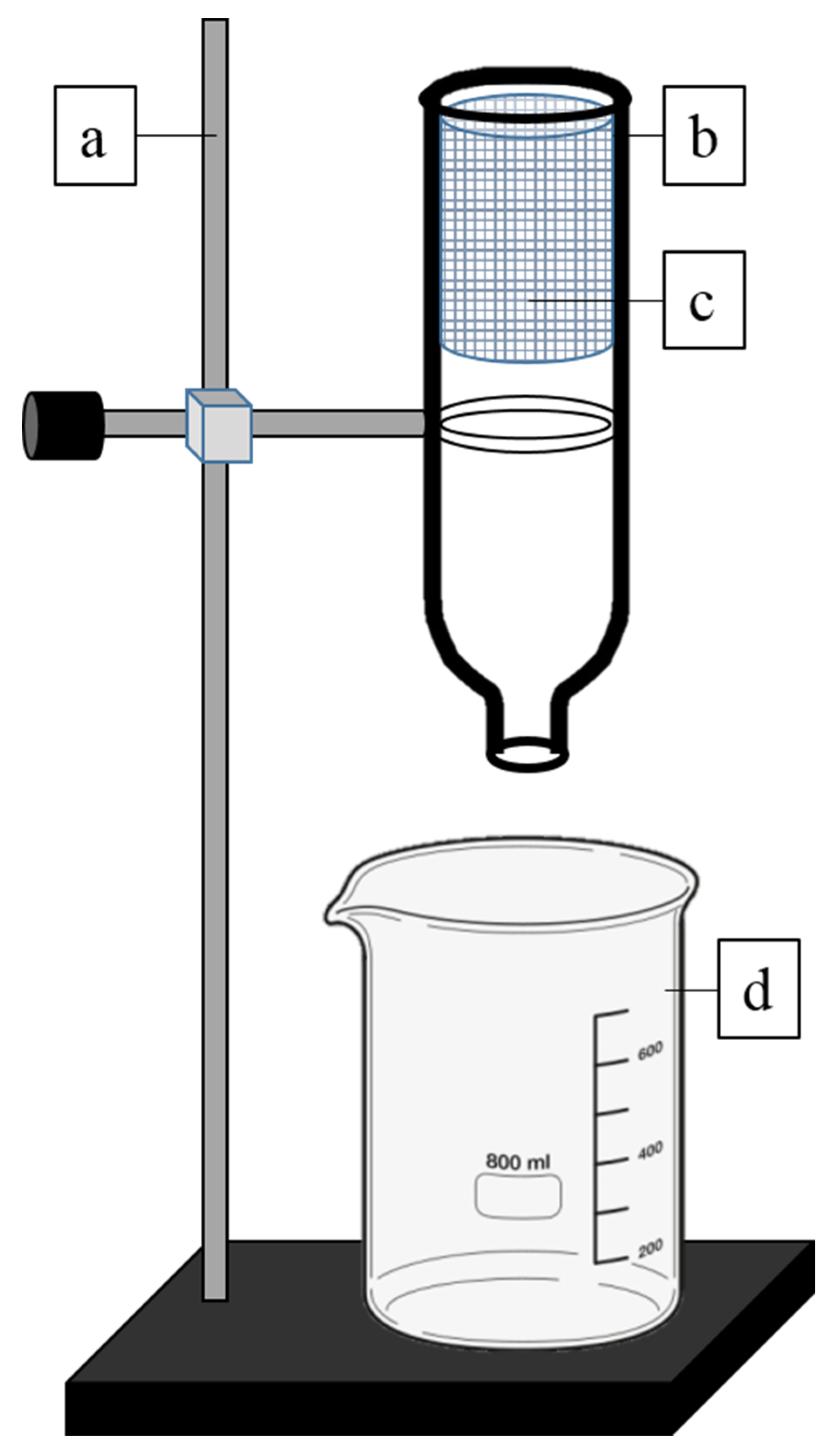

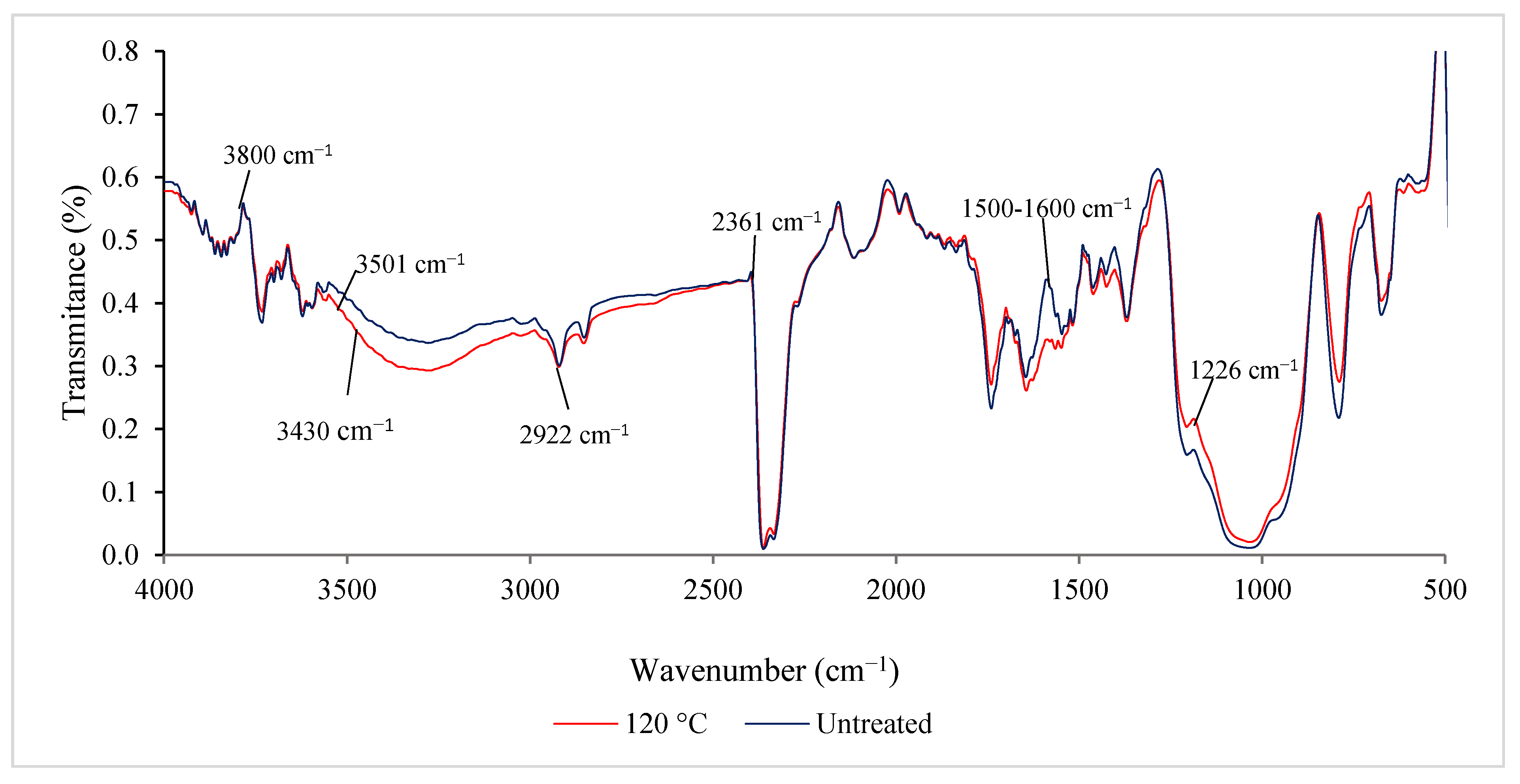


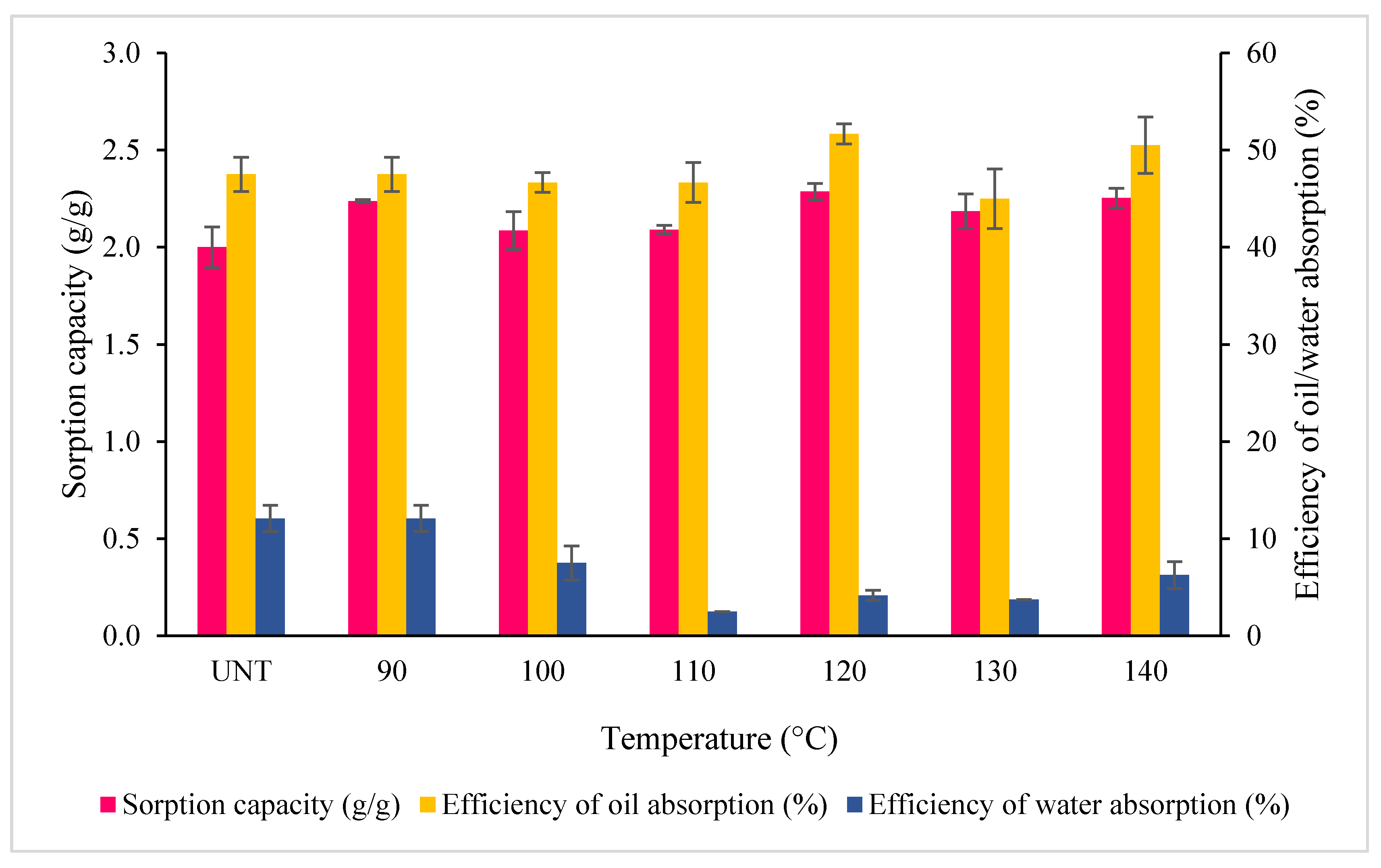
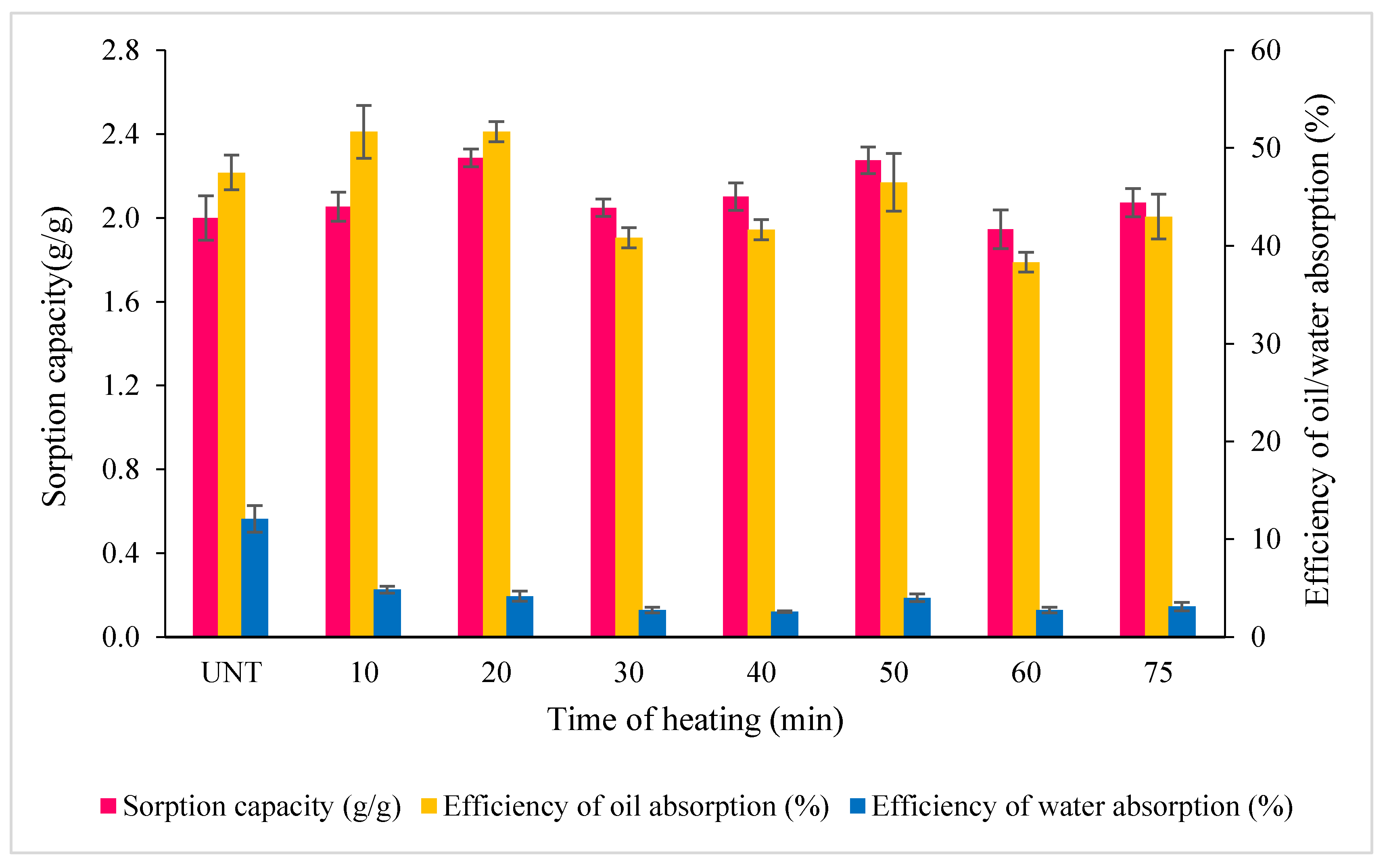
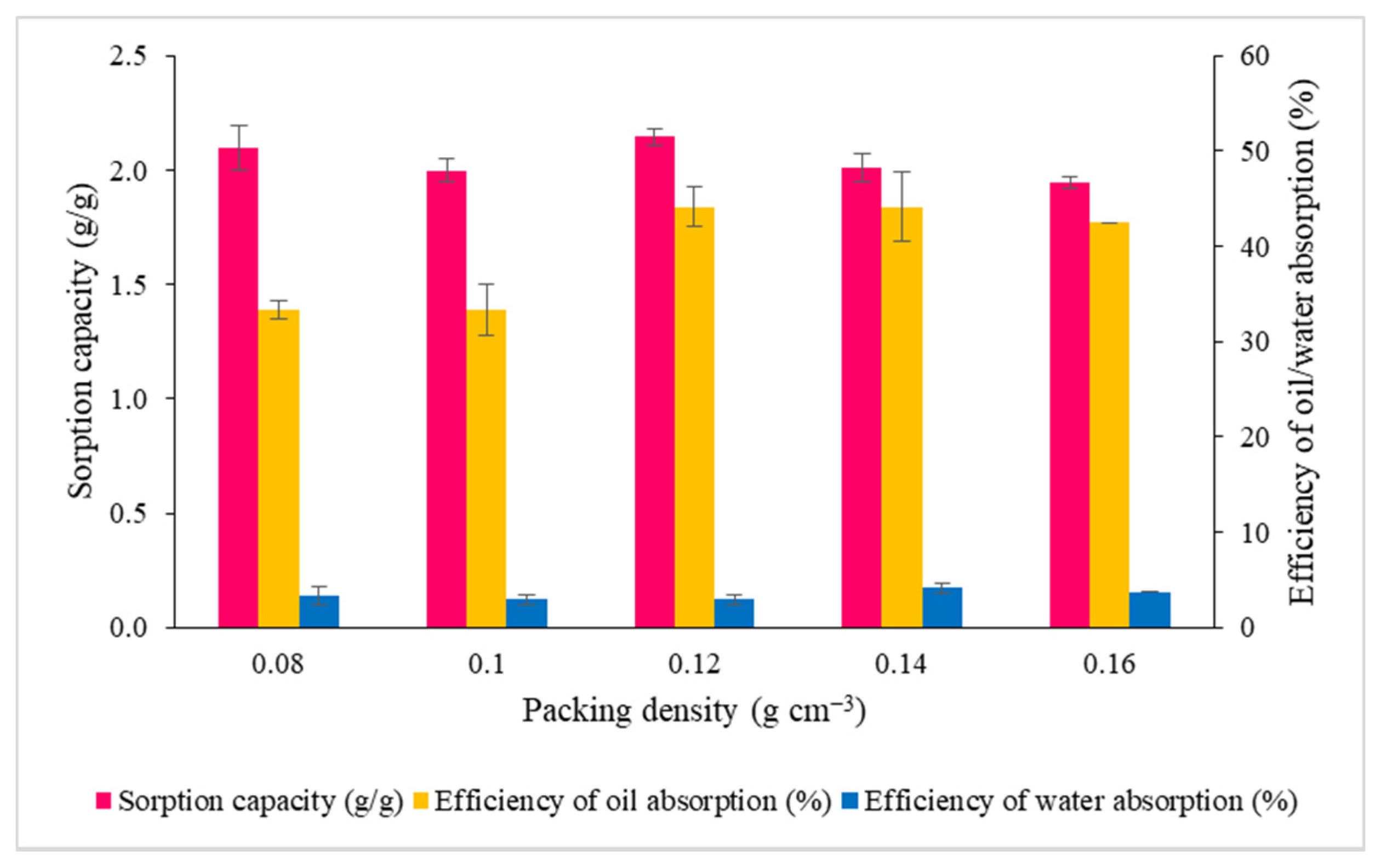
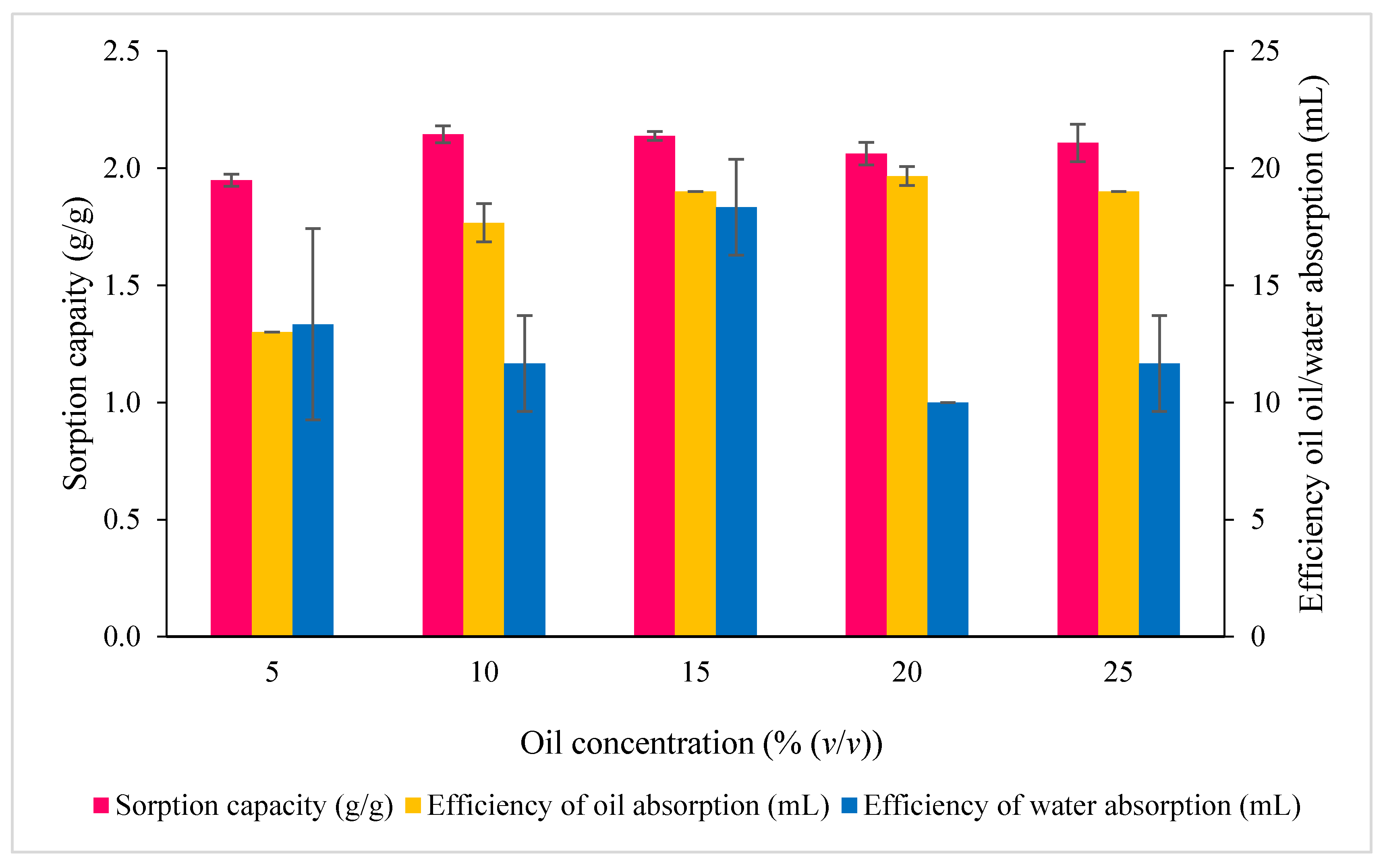

| Factors | Code | Unit | Experimental Range | |
|---|---|---|---|---|
| Low (−1) | High (+1) | |||
| Temperature | A | °C | 90 | 130 |
| Time of heating | B | min | 10 | 70 |
| Packing density | C | g cm−3 | 0.08 | 0.16 |
| Oil concentration | D | % (v/v) | 5 | 25 |
| Factors | Code | Unit | Experimental Values | ||||
|---|---|---|---|---|---|---|---|
| −2 | −1 | 0 | +1 | +2 | |||
| Time of heating | A | min | 3.18 | 10 | 20 | 30 | 36.82 |
| Packing density | B | g cm−3 | 0.08 | 0.1 | 0.13 | 0.16 | 0.18 |
| Oil concentration | C | % (v/v) | 4.88 | 10 | 17.5 | 25 | 30.11 |
| Wavenumber (cm−1) | Band Assignments | Movement/Vibration | References |
|---|---|---|---|
| 1226 | Si–O–Si Si=O | Stretching of silica | [13,14,22,37] |
| 1500–1600 | ʋ (C=C) | Stretching vibration between alkenes and aromatic functional groups | |
| 2922 | ʋ (C–H) | One of the peaks for cellulose, CH stretching | |
| 3430–3501 | ʋ (O–H) | Stretching of free hydroxyl groups | |
| 848 | Si–H | Peak of silica and hydrogen interaction | |
| 1021 | C–O C–O–C | A sharp and strong band is attributed to C-O stretching in cellulose, hemicelluloses and lignin or C-O-C stretching in cellulose and hemicelluloses | |
| 1637 | H–O–H | Stretching of water absorbed | |
| 1781 | C=O | The absorption of carbonyl stretching of ester and carboxyl groups, which are the most abundant in straw hemicellulose | |
| 2912 | C–H | Stretching vibration with the presence of alkenes/alkyl group in diesel oil | |
| 3300 | O–H | Intermolecular hydrogen bond |
| Std | Run | A | B | C | D | Response 1 Oil Absorbed (mL) | Response 2 Water Absorbed (mL) |
|---|---|---|---|---|---|---|---|
| 3 | 1 | 130 | 10 | 0.16 | 25 | 30.6667 | 15 |
| 12 | 2 | 100 | 10 | 0.1 | 10 | 16 | 15.6667 |
| 18 | 3 | 115 | 20 | 0.13 | 17.5 | 19.6667 | 10 |
| 11 | 4 | 130 | 10 | 0.16 | 25 | 30.6667 | 15 |
| 14 | 5 | 115 | 20 | 0.13 | 17.5 | 19.6667 | 10 |
| 16 | 6 | 115 | 20 | 0.13 | 17.5 | 19.6667 | 10 |
| 13 | 7 | 115 | 20 | 0.13 | 17.5 | 19.6667 | 10 |
| 7 | 8 | 130 | 10 | 0.1 | 10 | 16.6667 | 11.6667 |
| 9 | 9 | 130 | 30 | 0.16 | 10 | 20.3333 | 18 |
| 1 | 10 | 130 | 30 | 0.1 | 25 | 16 | 8.3333 |
| 4 | 11 | 100 | 30 | 0.1 | 25 | 19.6667 | 10 |
| 17 | 12 | 115 | 20 | 0.13 | 17.5 | 19.6667 | 10 |
| 6 | 13 | 100 | 10 | 0.1 | 25 | 21.6667 | 8.3333 |
| 8 | 14 | 130 | 30 | 0.1 | 10 | 16 | 10 |
| 15 | 15 | 115 | 20 | 0.13 | 17.5 | 19.6667 | 10 |
| 5 | 16 | 100 | 10 | 0.16 | 10 | 20.3333 | 20 |
| 10 | 17 | 100 | 30 | 0.16 | 25 | 25.6667 | 11.6667 |
| 2 | 18 | 100 | 30 | 0.16 | 10 | 18.6667 | 20 |
| Source | Sum of Squares | DF | Mean Square | F-Value | p-Value | |
|---|---|---|---|---|---|---|
| Model | 283.59 | 4 | 70.90 | 31.05 | <0.0001 | *** |
| A | 5.79 | 1 | 5.79 | 2.53 | 0.1374 | |
| B | 32.23 | 1 | 32.23 | 14.12 | 0.0027 | ** |
| C | 135.56 | 1 | 135.56 | 59.37 | <0.0001 | *** |
| D | 110.01 | 1 | 110.01 | 48.18 | <0.0001 | *** |
| Curvature | 7.41 | 1 | 7.41 | 3.25 | 0.0968 | |
| Residual | 27.40 | 12 | 2.28 | |||
| Lack of Fit | 27.40 | 6 | 4.57 | |||
| Pure Error | 0.0000 | 6 | 0.0000 | |||
| Cor Total | 318.40 | 17 | ||||
| Std. Dev. | 1.51 | R2 | 0.9119 | |||
| Mean | 20.57 | Adjusted R2 | 08825 | |||
| C.V.% | 7.34 | Predicted R2 | 0.7411 | |||
| Adeq Precision | 18.4041 | |||||
| Std | Run | A | B | C | Response 1 Oil Absorbed (mL) | Response 2 Water Absorbed (mL) |
|---|---|---|---|---|---|---|
| 12 | 1 | 20 | 0.180454 | 17.5 | 26 | 15.6667 |
| 16 | 2 | 20 | 0.13 | 17.5 | 19.6667 | 15 |
| 20 | 3 | 20 | 0.13 | 17.5 | 19.6667 | 15 |
| 14 | 4 | 20 | 0.13 | 30.1134 | 22.1067 | 13 |
| 18 | 5 | 20 | 0.13 | 17.5 | 19.6667 | 15 |
| 4 | 6 | 30 | 0.16 | 10 | 19.3333 | 15 |
| 15 | 7 | 20 | 0.13 | 17.5 | 19.6667 | 15 |
| 2 | 8 | 30 | 0.1 | 10 | 12.3333 | 9 |
| 19 | 9 | 20 | 0.13 | 17.5 | 19.6667 | 15 |
| 10 | 10 | 36.8179 | 0.13 | 17.5 | 22 | 15 |
| 1 | 11 | 10 | 0.1 | 10 | 16.5 | 13.3333 |
| 3 | 12 | 10 | 0.16 | 10 | 21 | 16.6667 |
| 7 | 13 | 10 | 0.16 | 25 | 28 | 15 |
| 13 | 14 | 20 | 0.13 | 4.88655 | 9.6 | 15.6667 |
| 5 | 15 | 10 | 0.1 | 25 | 19.3333 | 10 |
| 9 | 16 | 3.18207 | 0.13 | 17.5 | 24.6667 | 16 |
| 11 | 17 | 20 | 0.0795462 | 17.5 | 11.3333 | 15 |
| 6 | 18 | 30 | 0.1 | 25 | 15.6667 | 10 |
| 8 | 19 | 30 | 0.16 | 25 | 23.6667 | 15 |
| 17 | 20 | 20 | 0.13 | 17.5 | 19.6667 | 15 |
| Source | Sum of Squares | DF | Mean Square | F-Value | p-Value | |
|---|---|---|---|---|---|---|
| Model | 399.41 | 9 | 44.38 | 30.80 | <0.0001 | *** |
| A | 24.57 | 1 | 24.57 | 17.05 | 0.0020 | ** |
| B | 204.39 | 1 | 204.39 | 141.83 | <0.0001 | *** |
| C | 108.73 | 1 | 108.73 | 75.45 | <0.0001 | *** |
| AB | 0.4201 | 1 | 0.4201 | 0.2915 | 0.6011 | |
| AC | 0.5867 | 1 | 0.5867 | 0.4071 | 0.5378 | |
| BC | 3.34 | 1 | 3.34 | 2.3155 | 0.1591 | |
| A2 | 25.97 | 1 | 25.97 | 18.0191 | 0.0017 | ** |
| B2 | 1.36 | 1 | 1.36 | 0.9461 | 0.3536 | |
| C2 | 24.44 | 1 | 24.44 | 16.9586 | 0.0021 | ** |
| Residual | 14.41 | 12 | 2.28 | |||
| Lack of Fit | 14.41 | 6 | 4.57 | |||
| Pure Error | 0 | 6 | 0.0000 | |||
| Cor Total | 413.82 | 17 | ||||
| Std. Dev. | 1.20 | R2 | 0.9652 | |||
| Mean | 19.48 | Adjusted R2 | 0.9338 | |||
| C.V. % | 6.16 | Predicted R2 | 0.7307 | |||
| Adeq Precision | 19.8858 | |||||
| Optimized Factors | Value | Predicted Value | Experimental Value |
|---|---|---|---|
| Time of heating | 10 min | 26 mL of diesel with 14 mL of seawater * | 26 mL of diesel with 14 mL of seawater ± 1 mL * |
| Packing density | 0.148 g cm−3 | ||
| Oil concentration | 25% (v/v) |
Publisher’s Note: MDPI stays neutral with regard to jurisdictional claims in published maps and institutional affiliations. |
© 2021 by the authors. Licensee MDPI, Basel, Switzerland. This article is an open access article distributed under the terms and conditions of the Creative Commons Attribution (CC BY) license (https://creativecommons.org/licenses/by/4.0/).
Share and Cite
Taufik, S.H.; Ahmad, S.A.; Zakaria, N.N.; Shaharuddin, N.A.; Azmi, A.A.; Khalid, F.E.; Merican, F.; Convey, P.; Zulkharnain, A.; Abdul Khalil, K. Rice Straw as a Natural Sorbent in a Filter System as an Approach to Bioremediate Diesel Pollution. Water 2021, 13, 3317. https://doi.org/10.3390/w13233317
Taufik SH, Ahmad SA, Zakaria NN, Shaharuddin NA, Azmi AA, Khalid FE, Merican F, Convey P, Zulkharnain A, Abdul Khalil K. Rice Straw as a Natural Sorbent in a Filter System as an Approach to Bioremediate Diesel Pollution. Water. 2021; 13(23):3317. https://doi.org/10.3390/w13233317
Chicago/Turabian StyleTaufik, Siti Hajar, Siti Aqlima Ahmad, Nur Nadhirah Zakaria, Noor Azmi Shaharuddin, Alyza Azzura Azmi, Farah Eryssa Khalid, Faradina Merican, Peter Convey, Azham Zulkharnain, and Khalilah Abdul Khalil. 2021. "Rice Straw as a Natural Sorbent in a Filter System as an Approach to Bioremediate Diesel Pollution" Water 13, no. 23: 3317. https://doi.org/10.3390/w13233317
APA StyleTaufik, S. H., Ahmad, S. A., Zakaria, N. N., Shaharuddin, N. A., Azmi, A. A., Khalid, F. E., Merican, F., Convey, P., Zulkharnain, A., & Abdul Khalil, K. (2021). Rice Straw as a Natural Sorbent in a Filter System as an Approach to Bioremediate Diesel Pollution. Water, 13(23), 3317. https://doi.org/10.3390/w13233317










